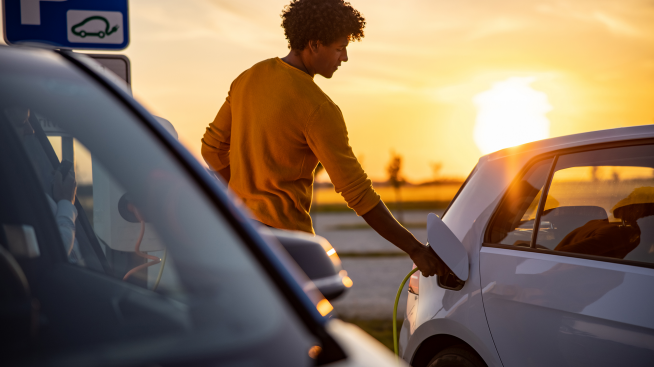Everything you need to know about EV charging

The infrastructure for electric vehicles (EVs) is still relatively new — and so are the rules and norms around using EV charging stations. What do you do if someone uses a charging spot to park? Is it okay to unplug an unattended vehicle once it’s fully charged? What about “topping off” past 80% when others are waiting?
Let’s set the record straight. Below are some generally recognized EV charging rules that will make charging at public stations easier and more pleasant for you and the other EV drivers in your community.
EV charging etiquette
Most members of the EV community view these EV charging rules as non-negotiable:
- Use EV charging stations to charge, not park. There are few things more frustrating for EV drivers than pulling into a station in need of a charge only to find a parked car blocking their access. If the offending car has an internal combustion engine, this is commonly called getting ICEd. Don’t do it if you drive an EV, either. Getting EVed is just as bad.
- Know which side your EV charger port is on. Unlike gas stations, many EV charging stations are configured such that chargers can be accessed from multiple parking spots. Be sure to park so that your port is close to the charger. You don’t want to commit the faux pas of having to pull a cable across someone else’s car.
- Park at the plug type compatible with your EV. For example, if you own a PHEV (plug-in hybrid), it was likely designed to use a slower Level 2 charger. Using a Level 3 rapid charger in a Level 2 port will be … not so rapid. It could take you hours, upsetting any EV drivers behind you who were expecting to wait mere minutes.
- Ensure that your car is properly plugged in and charging before leaving it unattended. Errors can occur within the first minute or two after plugging in, so don’t be too quick to walk away.
- Monitor your car while it’s charging and move on as soon as you're done (or when you reach the posted time limit). It’s acceptable (and common) to step away from your vehicle while it’s charging. But before you do, check for any signage noting time limits. Also, use a charging app to track your car’s progress. Pro Tip: The charging process typically slows down once you get past 80%, so those last few bars can add quite a bit of time to your charging session — and other drivers’ wait times. If reaching 80% is adequate to get you through your day, it’s courteous to let others charge-up sooner rather than later.
- Don’t unplug (or plug in) other people’s unattended cars without permission. This can be a tempting rule to break if the car ahead of you is fully charged — or even if you want to help someone out by plugging in their car when you’re done. It’s usually best to resist the urge, though. Many drivers believe you shouldn’t ever touch another person’s car. Exceptions may include instances where a driver leaves a note permitting you to plug or unplug them, or those rare times when an emergency arises and your car is about to lose power. There’s also the issue of open and closed port doors. Some EV drivers interpret an open port door as an invitation to plug in an unattended vehicle. Most agree, however, that closed port doors signal “hands off.”
- Put the handle back and coil the cable when you’re done. Otherwise, the cable could get damaged or be a tripping hazard.
Community etiquette
The sense of community in the EV world is strong. In addition to following EV charging etiquette, many also contribute to the larger community by following these helpful norms:
- Share EV charging station info with other EV drivers. The infrastructure for EVs is continually evolving. You can help other drivers stay in the loop by sharing news of any inoperable stations, rates, noteworthy amenities, and more through apps like ChargeHub, Electrify America and PlugShare.
- Avoid charging your EV at peak times during power shortages. For example, if a heat wave hits your region, local leaders may request that EV drivers voluntarily avoid charging during certain hours. You’ll probably save money if you do, too, since rates tend to go up at peak times.
- Be mindful of brand-based privileges. Some EV brands offer special EV charging stations only available to their own customers. If you have equal access to your brand-specific station and a general public station available to all EV models, it’s best to use your brand-specific station to help reduce wait times for other EV drivers.
In summary
We’ve all heard of the “rules of the road,” and the relatively new world of electric vehicles is creating a whole new chapter of that rulebook. In particular, charging up at public stations — which takes longer than filling up at the gas pump — is leading to the creation of new norms related to how long to leave your vehicle, whether to plug or unplug an unattended vehicle, and whether to “top off” past 80% when others are waiting. Some common etiquette can make charging at public stations easier and more pleasant for EV drivers.
To learn more above EVs, visit www.Chase.com/EV.



